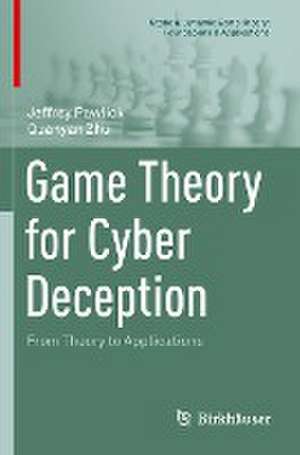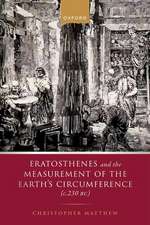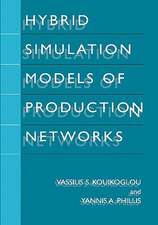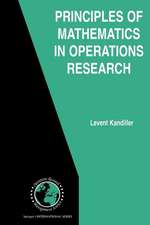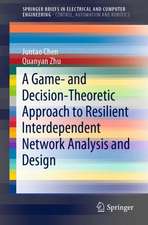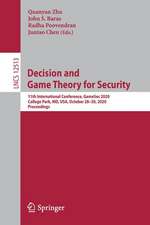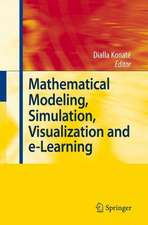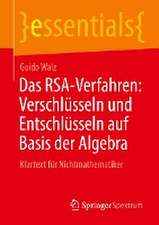Game Theory for Cyber Deception: From Theory to Applications: Static & Dynamic Game Theory: Foundations & Applications
Autor Jeffrey Pawlick, Quanyan Zhuen Limba Engleză Paperback – 31 ian 2022
This book introduces game theory as a means to conceptualize, model, and analyze cyber deception. Drawing upon a collection of deception research from the past 10 years, the authors develop a taxonomy of six species of defensive cyber deception. Three of these six species are highlighted in the context of emerging problems such as privacy against ubiquitous tracking in the Internet of things (IoT), dynamic honeynets for the observation of advanced persistent threats (APTs), and active defense against physical denial-of-service (PDoS) attacks. Because of its uniquely thorough treatment of cyber deception, this book will serve as a timely contribution and valuable resource in this active field.
The opening chapters introduce both cybersecurity in a manner suitable for game theorists and game theory as appropriate for cybersecurity professionals. Chapter Four then guides readers through the specific field of defensive cyber deception. A key feature of the remaining chapters is the development of a signaling game model for the species of leaky deception featured in honeypots and honeyfiles. This model is expanded to study interactions between multiple agents with varying abilities to detect deception.Game Theory for Cyber Deception will appeal to advanced undergraduates, graduate students, and researchers interested in applying game theory to cybersecurity. It will also be of value to researchers and professionals working on cybersecurity who seek an introduction to game theory.
The opening chapters introduce both cybersecurity in a manner suitable for game theorists and game theory as appropriate for cybersecurity professionals. Chapter Four then guides readers through the specific field of defensive cyber deception. A key feature of the remaining chapters is the development of a signaling game model for the species of leaky deception featured in honeypots and honeyfiles. This model is expanded to study interactions between multiple agents with varying abilities to detect deception.Game Theory for Cyber Deception will appeal to advanced undergraduates, graduate students, and researchers interested in applying game theory to cybersecurity. It will also be of value to researchers and professionals working on cybersecurity who seek an introduction to game theory.
| Toate formatele și edițiile | Preț | Express |
|---|---|---|
| Paperback (1) | 697.94 lei 6-8 săpt. | |
| Springer International Publishing – 31 ian 2022 | 697.94 lei 6-8 săpt. | |
| Hardback (1) | 704.19 lei 6-8 săpt. | |
| Springer International Publishing – 31 ian 2021 | 704.19 lei 6-8 săpt. |
Preț: 697.94 lei
Preț vechi: 872.41 lei
-20% Nou
Puncte Express: 1047
Preț estimativ în valută:
133.57€ • 145.03$ • 112.20£
133.57€ • 145.03$ • 112.20£
Carte tipărită la comandă
Livrare economică 22 aprilie-06 mai
Preluare comenzi: 021 569.72.76
Specificații
ISBN-13: 9783030660673
ISBN-10: 3030660672
Ilustrații: XIII, 190 p. 62 illus., 53 illus. in color.
Dimensiuni: 155 x 235 mm
Greutate: 0.3 kg
Ediția:1st ed. 2021
Editura: Springer International Publishing
Colecția Birkhäuser
Seria Static & Dynamic Game Theory: Foundations & Applications
Locul publicării:Cham, Switzerland
ISBN-10: 3030660672
Ilustrații: XIII, 190 p. 62 illus., 53 illus. in color.
Dimensiuni: 155 x 235 mm
Greutate: 0.3 kg
Ediția:1st ed. 2021
Editura: Springer International Publishing
Colecția Birkhäuser
Seria Static & Dynamic Game Theory: Foundations & Applications
Locul publicării:Cham, Switzerland
Cuprins
Part I Fundamentals.- Introduction.- Nash and Stackelberg Games.- Introduction to Incomplete Information.- Part II Defensive Deception.- A Taxonomy of Defensive Deception.- Obfuscation.- Honey-X.- Attacker Engagement.- Part III Mitigation of Malicious Deception.- Strategic Trust.- Active Crowd Defense.- Part IV Challenges and Opportunities in Cyber Deception.- Insights and Future Directions.- Current Challenges in Cyber Deception.
Recenzii
“The book is a good approach for abstracting the essentials of IoT allowing to model designing optimal, robust, and multi-layered approaches to defensive deception and counter-deception. It will be a good help for both scholars and persons involved in the practical issues of cyber-protection.” (Carlos Narciso Bouza Herrera, zbMATH 1484.91002, 2022)
Textul de pe ultima copertă
This book introduces game theory as a means to conceptualize, model, and analyze cyber deception. Drawing upon a collection of deception research from the past 10 years, the authors develop a taxonomy of six species of defensive cyber deception. Three of these six species are highlighted in the context of emerging problems such as privacy against ubiquitous tracking in the Internet of things (IoT), dynamic honeynets for the observation of advanced persistent threats (APTs), and active defense against physical denial-of-service (PDoS) attacks. Because of its uniquely thorough treatment of cyber deception, this book will serve as a timely contribution and valuable resource in this active field.
The opening chapters introduce both cybersecurity in a manner suitable for game theorists and game theory as appropriate for cybersecurity professionals. Chapter Four then guides readers through the specific field of defensive cyber deception. A key feature of the remaining chapters is the development of a signaling game model for the species of leaky deception featured in honeypots and honeyfiles. This model is expanded to study interactions between multiple agents with varying abilities to detect deception.
Game Theory for Cyber Deception will appeal to advanced undergraduates, graduate students, and researchers interested in applying game theory to cybersecurity. It will also be of value to researchers and professionals working on cybersecurity who seek an introduction to game theory.
Game Theory for Cyber Deception will appeal to advanced undergraduates, graduate students, and researchers interested in applying game theory to cybersecurity. It will also be of value to researchers and professionals working on cybersecurity who seek an introduction to game theory.
Caracteristici
Introduces game theory as a means to conceptualize, analyze, and model cyber deception Develops a thorough game-theoretic taxonomy to identify and investigate emerging problems in cybersecurity Includes a broad range of game-theoretic models, such as large-population games and games of incomplete information
